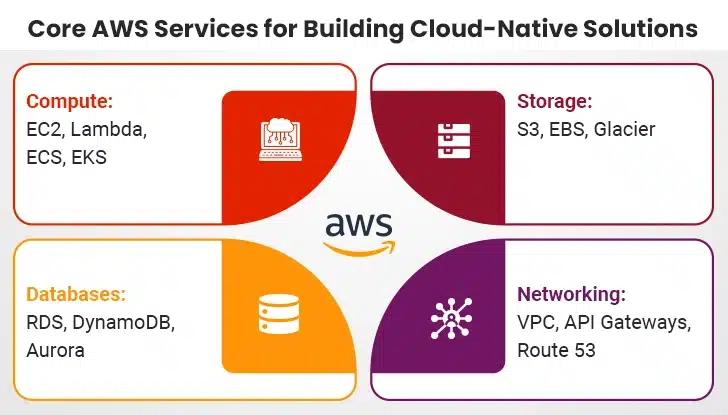Businesses around the world prominently use cloud-native applications as they enable companies to develop secure, scalable, and efficient apps. Traditional monolithic practices are not efficient to maximize operational expectations and performance. This is where cloud-native architecture demonstrates the benefits, especially AWS (Amazon Web Services).

AWS has a robust ecosystem that allows companies to meet customers’ expectations by avoiding manual scaling procedures. Furthermore, AWS architecture builds applications leveraging serverless functions and immutable infrastructure, enhancing modularity and elasticity. It provides a globally distributed infrastructure and highly personalized services for event-driven serverless execution, container orchestration, and efficient relational databases.
Let’s comprehend the valuable aspects of modernizing applications on AWS, best practices, challenges, and many more.
Table of Contents
Key AWS Services for Cloud-Native Architecture
Core AWS Services for Building Cloud-Native Solutions
The AWS Well-Architected Framework
- I. Operational Excellence
- II. Security
- III. Reliability
- IV. Performance Efficiency
- V. Cost Optimization
- VI. Sustainability
How the Framework Helps in Cloud-Native Design
Best Practices for Cloud-Native Design on AWS
Core Skills to Succeed as an AWS Cloud Architect
Overcoming Cloud-Native Design Hurdles with Proven Solutions
Key AWS Services for Cloud-Native Architecture
With the advancement of cloud computing, AWS has provided crucial utilities that aim to automate, simplify, and improve productivity. Let’s look at major AWS services and how they might help businesses in daily activities.

Compute: EC2, Lambda, ECS, EKS
AWS Compute is the backbone of your applications. EC2 allows users to easily create virtual servers, granting freedom, and control while avoiding complications. Lambda takes it a step further by executing your code without managing servers. ECS and EKS take care of your containers and orchestrate your application’s infrastructure so that you can concentrate on coding.
Storage: S3, EBS, Glacier
AWS Storage is the cloud repository where all your data is stored. Amazon S3 offers reliable and scalable storage for various data types, including images, videos, and documents, which can be accessed by users whenever needed. You can depend on EBS for block storage for your virtual servers, as it is attached directly and ensures rapid access. When data must be saved but rarely accessed, Glacier serves the best secured long-term storage.
Databases: RDS, DynamoDB, Aurora
AWS Databases provides a range of tailored data management and data management services, and classic computer science principles. Automated RDS enhancements add the ability to cloudy relational database management systems by EBS, providing images of common databases. NoSQL databases are highly efficient and reliable, often used for mobile or web applications for high speed and less flexible DynamoDB.
Networking: VPC, API Gateways, Route 53
A cloud-native system depends on networking to integrate all its components. Businesses using Amazon VPC have the ability to establish private cloud-based networks that grant them complete control of their network traffic patterns along with security protocols and subnet parameters. API Gateway is the gateway for backend service access, while handling API service operations through authentication and throttling functions. The DNS routing and endpoint failover capabilities of Route 53 allow your traffic to reach its closest and operational targets. Modern applications depend on these services to establish protected and reliable globally distributed network communication.
Discover proven strategies and essential best practices to elevate your cloud-native skills
The AWS Well-Architected Framework
The AWS Well-Architected Framework develops a complete system for architects to construct, evaluate, and improve cloud workloads. By leveraging these six pillars, AWS cloud architects can address each critical dimension of cloud-native architecture design. Let’s take a closer look!
I. Operational Excellence
Organizations realize operational excellence by documenting processes properly and monitoring everything through automation while prioritizing process improvement. AWS solution architect professional can anticipate and handle operational problems during service delivery because of this system. Effective operational practices result in shorter downtimes, improved functionality, and faster project deployments.
II. Security
The use of systems and data exists under an organization’s complete set of security policies to establish security. AWS cloud architect protects data through identity management and data protection systems, which decreases your security risks and compliance obstacles. Security measures protect your resources by reducing risks, which helps sustain customer trust.
III. Reliability
Applications remain available during adverse conditions thanks to reliability practices. Rapid reappearance after setbacks happens through automatic recovery and by testing for fault tolerance and implementing redundancy. Reliability delivers dependable functionality, reduces system downtime, upholds business standing, and delivers ongoing user stability.
IV. Performance Efficiency
Effective resource management for maximum performance results represents performance efficiency. AWS computing services deliver prompt responses together with high-quality work, maintaining affordable expenses. Efficient performance optimization will let businesses provide top-quality user services and utilize resources optimally and strengthen your infrastructure investments.
V. Cost Optimization
The approach of cost optimization centers on collecting resource visibility together with management capabilities to aid strategic planning efforts. Through AWS, users can access a cost-reduction platform that upholds all quality specifications. Leadership in cost management creates protection against budget overruns, strengthens financial governance, and achieves the optimal value from cloud investments.
VI. Sustainability
Sustainability depends on responsible environmental action, which uses resources more efficiently for better performance. Through AWS architect solutions, organizations can create applications that consume less energy while reducing their carbon emissions and supporting long-term environmental conservation. Organizations can achieve environmental goal alignment with their cloud strategies by working with an AWS cloud architect to implement sustainable practices.
How the Framework Helps in Cloud-Native Design
The AWS Well-Architected Framework delivers an organized method for creating cloud-native systems that provide scalability, resilient operations, security measures, and cost optimization. The framework provides businesses with a systematic measurement method to construct cloud applications that go beyond subjective guesses and random decisions. Let’s comprehend in detail!
Promotes Consistent Operational Practices
Operational excellence presents three key elements to standardize operations through automated systems, real-time feedback, and continuous progression. Standardized operational techniques, including infrastructure as code with real-time monitoring features, find promotion through their implementation. The deployment speed and rollback capability, combined with fewer manual mistakes, make cloud-native systems optimal in operations at scale.
Builds Security into Every Layer
Security must be integrated into the architecture design during its initial development phase rather than added as an afterthought. Organizations can achieve security through the security pillar, which instructs AWS solution architects to apply the least privileged access permissions and encryption. Architecting on AWS also involves implementing automated threat detection methods and continuous systems change auditing. Security guardrails are the fundamental elements to maintain system security when operating a cloud-native environment. It also includes dynamic resources and multiple services without restricting development speed.
Enhances System Resilience
Cloud-native relies on reliability as a core principle that requires systems to operate without interruption throughout hardware and network failures. The reliability content of the framework suggests distributed workloads alongside failover automation health checks and disaster recovery. Systems maintain high-end user uptime through failure recovery capabilities, which allows them to operate after problems occur.
Encourages Efficient Resource Use
The cloud-native should exclude situations where resources are either excessively allocated or underutilized. Performance efficiency is a pillar that enables architects to connect workloads with their proper hardware combinations, including computing and storage components. The recommendations state that elasticity by real-time demand-based resource scaling should be combined with optimized managed service deployments. A system with this feature maintains peak performance while eliminating unnecessary resource usage.
Keeps Costs Aligned with Value
When cost tracking is absent, it can become problematic during the execution of cloud-native workloads. Through active cost management, the cost optimization pillar identifies unused resources, suggests the use of reserved and spot instances. It also helps automate budget enforcement. Implementing these procedures helps organizations achieve better results between performance demands and financial stability.
Best Practices for Cloud-Native Design on AWS
Here are the most effective best practices businesses should follow with AWS cloud architects to achieve maximum results in their cloud-native journey. These practices help build fast, secure, scalable, and cost-effective platforms while ensuring efficient system deployment.
1. Scalability & Performance
Your application should easily handle growing traffic and demands. Use AWS services like auto scaling to adjust resources automatically, ensuring smooth performance even during peaks. Regularly assess and fine-tune your setup for consistent speed and efficiency.
Strategic Approach
- Running load testing helps identify future performance problems in applications.
- Predictive analytics combined with historical usage patterns enables AWS cloud architects to achieve optimal resource distribution.
- Add CloudFront as a content delivery network to increase global content delivery speed.
2. Security & Compliance
Protect your data and applications by setting clear boundaries. Implement AWS security services such as Identity and Access Management (IAM) to control who can access your systems. Regular audits and adherence to compliance standards keep your digital environment secure and trustworthy.
Strategic Approach
- Your CI/CD pipeline requires automatic vulnerability detectors and automated system patching implementations.
- Your business needs to begin implementation of industry-specific compliance frameworks such as HIPAA as well as GDPR from the start.
- Security best practices receive ongoing education from development teams, enabling them to stay knowledgeable about current practices.
3. High Availability & Fault Tolerance
Keep your applications running smoothly despite issues or outages. Design your infrastructure to automatically recover using AWS tools like Availability Zones and load balancing.
Strategic Approach
- Chaos engineering tests should be used for proactive damage identification.
- An organization must establish and maintain a complete disaster recovery plan that needs regular updates.
- Your system uses automatic alert systems to track infrastructure conditions in real-time.
4. Cost Optimization
Smart budgeting helps you maximize your AWS investments. Monitor resource usage closely to avoid unnecessary spending. Regular reviews and adjustments to your AWS setup ensure you’re getting the best value without compromizing quality.
Strategic Approach
- An appropriate tag system should be designed to provide enhanced visibility into how resources get used together with their cost details.
- Organizations should assess the price versus performance benefits of AWS services at regular intervals.
- Leverage reserved instances and savings plans strategically for predictable workloads.
5. Automation & Infrastructure as Code (IaC)
Simplify and standardize your processes with automation. Treat infrastructure as code using AWS CloudFormation or Terraform, ensuring consistency and reducing manual errors. Automation acts like a dependable assistant, managing repetitive tasks precisely every time.
Strategic Approach
- Infrastructure templates should have a version control system in place to monitor changes and maintain teamwork.
- Your system should implement automation technology for infrastructure compliance assessments and automatic enforcement systems.
- Keep infrastructure code updated to use new abilities offered by AWS.
6. Observability & Monitoring
Maintain clear visibility into your application’s health and performance. Use AWS CloudWatch and similar tools to track metrics and spot potential issues early. Like a car dashboard, good monitoring helps you proactively address problems, keeping everything running smoothly.
Strategic Approach
- Organizations need to specify quantitative goals that directly serve company objectives.
- Alert thresholds must become automated because they enable fast responses to anomalous conditions.
- The organization needs to evaluate its monitoring tools and methods frequently to maintain performance and adaptability.
Core Skills to Succeed as an AWS Cloud Architect
Let’s explore the key skills that form the foundation of cloud-native design on AWS. From mastering automation and security practices to knowing observability and cost management techniques, earning an AWS architect certification equips professionals to deliver scalable, reliable, and efficient solutions.
| Skills Area | Why It’s Important |
|---|---|
| Cloud Computing Fundamentals | Provides a strong foundation for understanding various cloud models, their benefits, and how they align with effective cloud migration strategies. |
| AWS Services | Familiarity with core AWS services enables effective design and deployment of solutions. |
| DevOps and Automation | Streamlines infrastructure management and enables continuous integration and delivery. |
| Programming Languages | Facilitates the development of scalable and maintainable cloud-native applications. |
| Networking & Security | Ensures robust connectivity and protects data and systems within the cloud. |
| Containerization & Orchestration | Simplifies application deployment and management through containerized environments. |
| Serverless Computing | Reduces infrastructure overhead and allows for highly efficient, event-driven architecture. |
| Database Management | Ensures efficient storage, retrieval, and analysis of data for cloud-based applications. |
Unlock smarter, cost-effective, and secure cloud-native designs to accelerate your growth
Overcoming Cloud-Native Design Hurdles with Proven Solutions
The implementation of cloud-native designs includes distinctive sets of difficulties. Complex systems tend to increase in difficulty as they grow in size until proper strategy implementation fails to mitigate losing control. These specific obstacles face most businesses in their operations, yet solutions exist to address them efficiently.
Challenge: Addressing the complexity of distributed systems
Solution: Embrace service mesh architectures like Istio or Linkerd to simplify service discovery, load balancing, traffic management, and observability. When combined with orchestration tools like Kubernetes, these meshes streamline deployment, scaling, and system management. An AWS cloud solution architect can further enhance this setup by leveraging AWS-native tools and best practices, ensuring a scalable and resilient cloud-native environment.
Challenge: Maintaining security tight in a dynamic environment
Solution: Adopt zero-trust security best practices. Implement identity-based access controls (IAM), encrypt data in transit and at rest, and integrate security scans into your CI/CD pipeline. HashiCorp Vault and AWS KMS are also perfect for securely handling secrets and keys.
Challenge: Providing high availability and resilience
Solution: Plan for failure from the ground up using practices such as circuit breakers, exponential backoff retries, and bulkheads. Leverage multi-zone and multi-region deployments for increased fault tolerance.
Challenge: Achieving Observability and Monitoring at Scale
Solution: Implement centralized logging, monitoring, and tracing using tools such as Prometheus, Grafana, the ELK stack, and OpenTelemetry. Ensure every microservice logs a structured log and exposes health endpoints for proactive health checking.
Challenge: Balancing cost optimization and performance
Solution: Use auto-scaling, serverless computing, and spot instances to scale resources based on demand dynamically. Monitor usage using cloud-native cost management tools (such as AWS Cost Explorer and Azure Cost Management) to avoid overprovisioning.
Final Thoughts
Developing cloud-native applications on AWS is a strategic and comprehensive process that necessitates a disciplined architectural method. With the assistance of the AWS architecture framework, businesses can efficiently develop robust and future-ready cloud-native solutions.
Furthermore, architecting on AWS helps not only large-sized businesses but also startups and growing businesses. Utilizing cloud-native design on AWS, it’s easy for companies to compute heavy workloads, deliver content globally, or manage massive datasets. As we have gone through this article, it is proven that this playbook navigates making smart decisions. But don’t treat it as a one-time reference. Revisit it as your application enhances, your team innovates, and your user’s demands rise. The best cloud-native systems succeed not just because of advanced technologies but because of a mindset focused on learning, exploring, and thoughtful planning. AWS brings the tools. You bring the directions.





